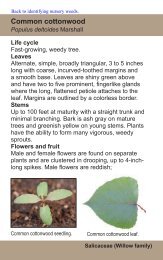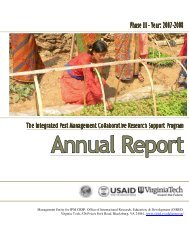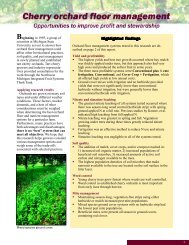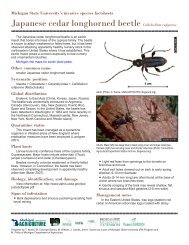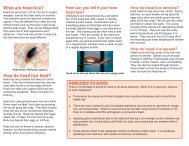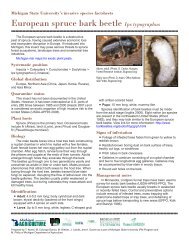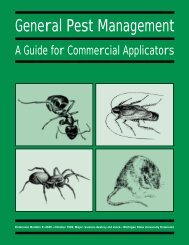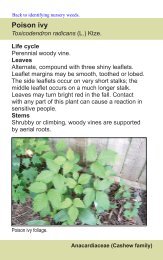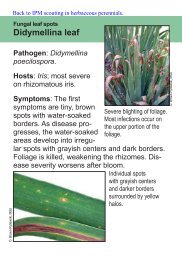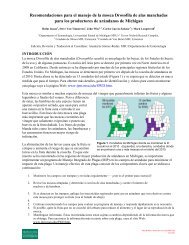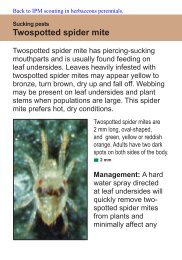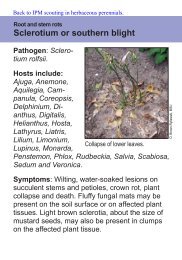Whole Manual - Michigan State University: Integrated Pest ...
Whole Manual - Michigan State University: Integrated Pest ...
Whole Manual - Michigan State University: Integrated Pest ...
Create successful ePaper yourself
Turn your PDF publications into a flip-book with our unique Google optimized e-Paper software.
FUNGUS (plural FUNGI)—A group of small, often<br />
microscopic, organisms in the plant kingdom that cause<br />
rot, mold and disease. Fungi need moisture or a damp<br />
environment (wood rots require at least 19 percent moisture).<br />
Fungi are extremely important in the diet of many<br />
insects.<br />
GENERAL-USE (UNCLASSIFIED) PESTICIDE—A<br />
pesticide that can be purchased and used by the general<br />
public. (See also restricted-use pesticide.)<br />
GEOGRAPHIC INFORMATION SYSTEM (GIS)—An<br />
organized collection of computer hardware, software,<br />
geographic data and personnel designed to capture,<br />
manipulate, analyze and display geographically referenced<br />
data.<br />
GENUS—See taxonomy<br />
GLOBAL POSITIONING SYSTEM (GPS)—Portable,<br />
satellite-based system which will establish the real-world<br />
location (position) of the GPS receiver.<br />
GRANULE—A dry pesticide formulation. The active<br />
ingredient is either mixed with or coated onto an inert<br />
carrier to form a small, ready-to-use, low-concentrate<br />
particle that normally does not present a drift hazard.<br />
Pellets differ from granules only in their precise uniformity,<br />
larger size, and shape.<br />
GROUNDWATER—Water sources located beneath the<br />
soil surface from which springwater, well water, etc., are<br />
obtained. (See also surface water.)<br />
HAZARD—See risk.<br />
HERBICIDE—A pesticide used to kill plants or inhibit<br />
plant growth.<br />
HOPPERBURN—A V-shaped yellow marking resulting<br />
from feeding of leafhoppers.<br />
HOST—Any animal or plant on or in which another lives<br />
for nourishment, development, or protection.<br />
HOST RESISTANCE—The defense mechanism of an<br />
animal or plant against a pest; sometimes host-plant<br />
resistance. See RESISTANCE.<br />
HYPHA (plural HYPHAE)—A single, delicate threadlike<br />
structure of fungus.<br />
IGR, INSECT GROWTH REGULATOR, JUVENOID—<br />
A pesticide constructed to mimic insect hormones that<br />
control molting and the development of some insect systems<br />
affecting the change from immature to adult. (See<br />
juvenile hormone.)<br />
INCUBATION PERIOD—The time between first exposure<br />
to a pathogen and when symptoms begin to appear.<br />
INERT INGREDIENT—In a pesticide formulation, an<br />
inactive material without pesticidal activity.<br />
INFECTION—The establishment of a pathogen with a<br />
host.<br />
INFECTIOUS DISEASE—Disease caused by pathogens<br />
such as bacteria, viruses, and fungi; can be spread from<br />
plant to plant.<br />
INGREDIENT STATEMENT—The portion of the label<br />
on a pesticide container that gives the name and amount<br />
of each active ingredient and the total amount of inert<br />
ingredients in the formulation.<br />
INHALATION—Taking a substance in through the<br />
lungs; breathing in. (See exposure route.)<br />
INOCULUM—A pathogen source that can infect and<br />
cause disease.<br />
INSECT GROWTH REGULATOR—See IGR.<br />
INSECTICIDE—A pesticide used to manage or prevent<br />
damage caused by insects. Sometimes generalized to be<br />
synonymous with pesticide.<br />
INSECTS, INSECTA—A class in the phylum<br />
Arthropoda characterized by a body composed of three<br />
segments (head, thorax, and abdomen) and three pairs of<br />
legs.<br />
INTEGRATED PEST MANAGEMENT— See IPM.<br />
IPM—<strong>Integrated</strong> pest management. A planned pest control<br />
program in which various methods are integrated<br />
and used to keep pests from causing economic, healthrelated,<br />
or aesthetic injury. IPM includes reducing pests<br />
to a tolerable level. <strong>Pest</strong>icide application is not the primary<br />
control method but is an element of IPM—as are<br />
cultural, mechanical, and biological methods. IPM programs<br />
emphasize communication, monitoring, inspection,<br />
and evaluation (keeping and using records).<br />
JUVENILE—The immature or larval stage of nematodes;<br />
commonly referred to as J1, J2, J3, and J4.<br />
JUVENILE HORMONE—A hormone produced by an<br />
insect that inhibits change or molting. As long as juvenile<br />
hormone is present, the insect does not develop into an<br />
adult but remains immature.<br />
LABEL—All printed material attached to or on a pesticide<br />
container.<br />
LABELING—The pesticide product label and other<br />
accompanying materials that contain directions that pesticide<br />
users are legally required to follow.<br />
LARVA (plural LARVAE)—An early developmental<br />
stage of insects with complete metamorphosis. Insects<br />
hatch out of eggs as larvae before becoming pupae (resting<br />
stage), and then adults.<br />
LC 50 —Lethal concentration. The concentration of a pesticide,<br />
usually in air or water, that kills 50 percent of a test<br />
population of animals. LC 50 is usually expressed in parts<br />
per million (ppm). The lower the LC 50 value, the more<br />
acutely toxic the chemical.<br />
LD 50 —Lethal dose. The dose or amount of a pesticide<br />
that can kill 50 percent of the test animals when eaten or<br />
absorbed through the skin. LD 50 is expressed in milligrams<br />
of chemical per kilogram of body weight of the<br />
test animal (mg/kg). The lower the LD 50 , the more acutely<br />
toxic the pesticide.<br />
LEACHING—The movement of a substance with water<br />
downward through soil.<br />
Vegetable Crop <strong>Pest</strong> Management<br />
95<br />
Appendix C



